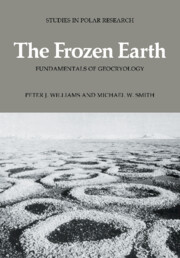Book contents
- Frontmatter
- Contents
- Symbols
- Preface
- Acknowledgements
- 1 PERIGLACIAL CONDITIONS
- 2 MORPHOLOGY OF PERMAFROST AND SEASONALLY FROZEN GROUND
- 3 CLIMATE AND FROZEN GROUND
- 4 THE GROUND THERMAL REGIME
- 5 THE FORMS OF THE GROUND SURFACE 1: SLOPES AND SUBSIDENCES
- 6 THE FORMS OF THE GROUND SURFACE 2: STRUCTURES AND MICROTOPOGRAPHY OF LEVEL GROUND
- 7 THERMODYNAMIC BEHAVIOUR OF FROZEN SOILS
- 8 HYDROLOGY OF FROZEN GROUND
- 9 THE MECHANICS OF FROZEN GROUND
- 10 GEOCRYOLOGY PAST AND FUTURE
- References
- Index
10 - GEOCRYOLOGY PAST AND FUTURE
Published online by Cambridge University Press: 24 October 2009
- Frontmatter
- Contents
- Symbols
- Preface
- Acknowledgements
- 1 PERIGLACIAL CONDITIONS
- 2 MORPHOLOGY OF PERMAFROST AND SEASONALLY FROZEN GROUND
- 3 CLIMATE AND FROZEN GROUND
- 4 THE GROUND THERMAL REGIME
- 5 THE FORMS OF THE GROUND SURFACE 1: SLOPES AND SUBSIDENCES
- 6 THE FORMS OF THE GROUND SURFACE 2: STRUCTURES AND MICROTOPOGRAPHY OF LEVEL GROUND
- 7 THERMODYNAMIC BEHAVIOUR OF FROZEN SOILS
- 8 HYDROLOGY OF FROZEN GROUND
- 9 THE MECHANICS OF FROZEN GROUND
- 10 GEOCRYOLOGY PAST AND FUTURE
- References
- Index
Summary
Geocryology and geotechnique
In this book we have been concerned with the scientific understanding of the cold regions. In doing so we build upon a long tradition that dates back to the early explorers, who were struck by the distinct terrain of these remote regions and the obvious contrasts with the temperate and inhabited regions from which they came. We have noted the diversity of terrain associated with cold climates, and that such conditions are not limited to the polar regions. Freezing of the ground also occurs to an important extent in regions that have been quite heavily populated for centuries. Parts of the Soviet Union, even Moscow itself, and much of southern Canada and the northern United States are characterised by very cold winters. In the cold regions more generally, however, including much of the Arctic, temperatures remain low in the summer as well, limiting plant growth, and native, nomadic populations have held sway until this century. Only with the arrival of European settlers intent on introducing urban centres and military, industrial and technological activities of various kinds, have these typical cold regions of the North been subject to more intense and practical investigation.
Technological innovation has also led to frozen ground having an importance quite unrelated to natural climatic conditions: artificial freezing to provide soil strength in civil engineering procedures such as tunnel and mine shaft construction is assuming an importance that makes studies of the behaviour of frozen ground as an engineering material imperative.
- Type
- Chapter
- Information
- The Frozen EarthFundamentals of Geocryology, pp. 272 - 279Publisher: Cambridge University PressPrint publication year: 1989



